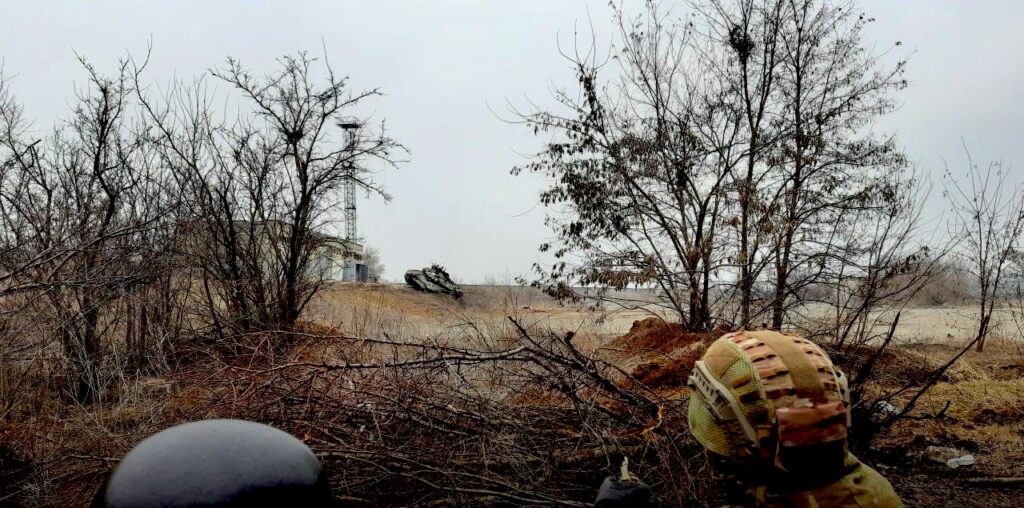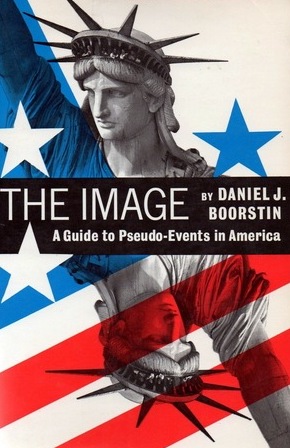The US Bubble of Pretend
MEDIA, 11 Apr 2022
Patrick Lawrence | Consortium News - TRANSCEND Media Service
The lack of objective, principled coverage of the war in Ukraine is a degenerate state of affairs. The one thing worse is the extent to which it’s perfectly fine with most North Americans.

Ukrainian government photo of soldiers during battle in Mariupol on March 15.
(CC BY 4.0, Wikimedia Commons)
5 Apr 2022 – It is perfectly obvious by now, to anyone who cares to look, that mainstream media in Anglo America and the other Western powers are not reporting the Ukraine crisis accurately.
Let me try that another way: The government-supervised New York Times and the rest of the corporate-owned media on both sides of the Atlantic lie routinely to their readers and viewers as to why Russia intervened in Ukraine, the progress of its military operation, the conduct of Ukrainian forces, and the United States of America’s role in purposely provoking and prolonging this crisis.
So far as I know, this is the first war in modern history with no objective, principled coverage in mainstream media of day-to-day events and their context. None. It is morn-to-night propaganda, disinformation and lies of omission — most of it fashioned by the Nazi-infested Zelensky regime in Kiev and repeated uncritically as fact.
There is one thing worse than this degenerate state of affairs. It is the extent to which the media’s malpractice is perfectly fine to most North Americans. Tell us what to think and believe no matter if it is true, they say, and we will think and believe it. Show us some pictures, for images are all.
There are larger implications to consider here. Critical as it is that we understand this conflict, Ukraine is a mirror in which we see ourselves as we have become. For more North Americans than I wish were so, reality forms only in images. These North Americans are no longer occupants of their own lives. Risking a paradox, what they take to be reality is detached from reality.
This majority — and it is almost certainly a majority — has no thoughts or views except those first verified through the machinery of manufactured images and “facts.” Television screens, the pages of purportedly authoritative newspapers, the air waves of government-funded radio stations — NPR, the BBC — serve to certify realities that do not have to be real, truths that do not have to be true.
This leaves us in a sad and very parlous place.
Sad: Is there some state more pitiful than having no genuine connection to one’s own thoughts, perceptions, experience—altogether to one’s life? If North Americans are not a profoundly sad people behind all the smiles we see in advertising, idiotic comedy shows, and on Facebook, then I must be missing something.
Parlous: Over the course of some decades — from the mid–Cold War years, I would say — North Americans have been rendered highly vulnerable to the manipulations of those who control the images through which most people have come to live. Anyone who has read a history of the 20th century knows where this can lead.
The five weeks that have passed since the Russian intervention on Feb. 24 have been shocking on both these counts. The derelictions of the press and broadcasters are without precedent in my lifetime, and with Vietnam, the Iraq War, and the covert operation in Syria among the wreckage in the rearview mirror, this is saying something.
I will let the U.S. public’s enthusiasm for the sinkhole that is Ukraine, the Azov Battalion, and the ridiculous posturing of President Volodymyr Zelensky, the comedian who is no longer funny, speak for itself.
‘Questionable Veracity’

Fan art of the “Ghost of Kyiv” by Andriy Dankovych. (CC BY-SA 4.0, Wikimeda Commons)
Ten days into the Russian intervention, the propaganda coming out of Kiev was already so preposterous The New York Times felt compelled to publish a piece headlined, “In Ukraine’s Information War, a Blend of Fact and Fiction.” This was a baldly rendered apologia for the many “stories of questionable veracity,” as The Times put it, then in circulation. I do love The Times for its delicate phrasing when describing indelicate matters.
There was the “Ghost of Kiev” story, featuring an heroic fighter pilot who turned out to derive from a video game. There were the Snake Island heroes, 13 Ukrainian soldiers who held out to the death on some small speck in the Black Sea, except that it turned out they surrendered, though not before Zelensky awarded them posthumous medals of honor that were not posthumous.
After railing against disinformation for years, The Times wants us to know, disinformation is O.K. in Ukraine because the Ukrainians are our side and they are simply “boosting morale.”
We cannot say we weren’t warned. The Ghost of Kiev and Snake Island turn out now to be mere prelude, opening acts in the most extensive propaganda operation of the many I can recall.
There was the maternity ward the Russians supposedly bombed in Mariupol. And then the theater, and then the art school. All filled with huddling citizens the Russian air force cynically targeted because “this is genocide,” as the ever-intemperate Zelensky does not hesitate to assert.
All of this has been reported as fact in the Times and other major dailies and, of course, by the major broadcasters. There have been pictures. There have been videos, all very persuasive to the eye.
And then, as evidence mounts that these incidents were staged as propaganda to frame the Russians and draw NATO forces directly into the war, a silence worthy of a Catholic chapel descends. We read no more of the maternity ward that turned out to be an improvised Azov base, or the theater, where citizens were herded, photographed in raggedy blankets, and sent away. Ditto the art school: Nothing more on this since the initial reports began to collapse. No body counts, no mention of the fact that Russian jets did not fly over Mariupol on the days in question.

Snake Island in Ukraine. (CC BY-SA 4.0, Wikimedia Commons)
Before proceeding to Bucha, the outrage of the moment, I must reproduce a quotation from that propaganda-is-O.K. piece The Times published in its March 3 editions. It is from a Twitter user who was distressed that it became public that the Ghost of Kiev turned out to be a ghost and the Snake Island heroes didn’t do much by way of holding the fort.
“Why can’t we just let people believe some things?” this thoughtful man or woman wanted to know. What is wrong, in other words, if thinking and believing nice things that aren’t true makes people feel better?
America the beautiful, or something like that.
Bucha is a suburb of 35,000 souls a few miles north of Kiev and one of the cities Russian forces began to evacuate on March 29 as peace talks in Istanbul progressed. Two days later the mayor, Anatoly Fedoruk, celebrated the city’s liberation in a selfie-speech to his citizenry. He made no mention of anything untoward in Bucha’s streets, backyards, or public spaces.
Four days later, April 2, a special unit of the Ukrainian national police deployed to Bucha. And suddenly the place turns out to be a hellhole: bodies in the streets — 410, according to the Prosecutor General’s office in Kiev — evidence of atrocities galore, people bound and shot point blank. The whole nine, in short.
Instant Outrage
The outrage from Washington, London and Paris — “worldwide outrage,” this would be — was instant. No demand for an impartial inquiry, forensic inspections, or any such thing. No one asked why corpses left in the street for five days appeared to be fresh, or why the relatives of the dead left them there until Kiev’s commando unit arrived.
António Guterres, the U.N. secretary-general, was level-headed enough to state, “It is essential that an independent investigation leads to effective accountability.” This is the only sound position at this point. But we know from a long history how far SGs at the U.N. get with this sort of talk.
In my read this is yet another of the false flags the Kiev regime flies almost by the day now. Paying-attention people will not miss the striking similarity between these incidents and the numerous put-up jobs that featured in Washington’s covert operation in Syria and the campaign of those famous “moderate rebels” who desperately wanted to draw the U.S. into the conflict.
As a matter of principle we must await evidence of what happened in Bucha, even as we know we are likely to see as much about events there as we have in Mariupol. We also know that to most people neither evidence nor its absence matters.
We have been told once again what to think and believe, and most of us will think and believe it.

Media engineer. (State Department/Ron Przysucha)
We are to add this to various other “truths” now almost universally accepted: The Russian intervention had nothing to do with NATO expansion and was “unprovoked” — that favored term in the Biden regime. Ukrainian forces have pushed the Russians into retreat: not that the pressure on Kiev was a Russian diversionary tactic to keep Ukrainian forces away from Donbass where the fighting is.
After the Pentagon Papers came out in 1971, Hannah Arendt published an essay in The New York Review of Books called “Lying in Politics.” In it she wrote of North America’s slide into a sort of collective psychosis she termed “defactualization.” Facts are fragile, Arendt wrote, in that they tell no story in themselves. They can be assembled to mean whatever one wants them to mean. This leaves them vulnerable to the manipulations of storytellers.
“The deliberate falsehood deals with contingent facts,” Arendt explained in this remarkable piece of work, “that is, with matters which carry no inherent truth within themselves, no necessity to be as they are; factual truths are never compellingly true.”
A dead body in a Ukrainian street, in other words, can be assigned a meaning that, once it is established, evidence to the contrary cannot be used to erase.
It is a half-century since Arendt published “Lying in Politics.” And it is to that time, the 1960s and 1970s, that we must trace the formation of what now amounts to North America’s great bubble of pretend. The world as it is has mattered less and less since Arendt’s time, the world as we have wished it to be has mattered more and more.
 Nine years before Arendt published her NYRB piece, Daniel Boorstin brought out The Image: Or, What happened to the North American Dream, an unjustly neglected work. “I describe the world of our making,” he wrote, “how we have used our wealth, our literacy, our technology, and our progress to create the thicket of unreality which stands between us and the facts of life.”
Nine years before Arendt published her NYRB piece, Daniel Boorstin brought out The Image: Or, What happened to the North American Dream, an unjustly neglected work. “I describe the world of our making,” he wrote, “how we have used our wealth, our literacy, our technology, and our progress to create the thicket of unreality which stands between us and the facts of life.”
The press, as you can imagine, did not escape Boorstin’s scrutiny. “The reporter’s task,” he wrote memorably, “is to find a way to weave these threads of unreality into a fabric the reader will not recognize as entirely unreal.”
This is our condition. The Ukraine crisis is the mirror that reflects us as we are.
Now I will relate a peculiar coincidence, pertinent to our case.
Last week I took it upon myself to watch Marcel Ophuls’ The Sorrow and the Pity, all four hours of it. This is the famously explosive documentary that forced the French to come to terms with the extent to which they had collaborated with the Nazis during the three years and some they occupied France.

Movie poster of an eye with a single teardrop and a tiny swastika near the pupil. (Wikimedia Commons)
This film has a special meaning for me. It came out in 1969, just as I arrived in Paris for university studies. France was in an uproar over Ophuls’ film. It was banned from broadcast on French television until 1981. I did not understand much of this at the time.
The Sorrow and the Pity shredded to pieces, relentlessly, unblinkingly, the national myth that the French had all been heroes of the resistance, or had aided it, or had in some way stood against the collaborationist Vichy regime of Marshal Pétain, hero of Verdun in World War I, capitulationist in World War II. This was nothing like the case.
Now I understand what the young student long ago could not quite grasp. The French simply could not face Ophuls’ unyielding exposure of who they had been. Ophuls had punctured the enduring bubble of pretend within which they had lived for 25 years after the 1945 victory in Europe.
People can live in these bubbles a very long time. The unreality within them can be very persuasive. The French finally emerged from their bubble. It was painful, a passage full of angst, but they were fortunate to have escaped.
Will we have our interim of sorrow, of pity, and emerge from our bubble the better for it? May we someday be so blest.
_________________________________________________
 Patrick Lawrence, a correspondent abroad for many years, chiefly for the International Herald Tribune, is a columnist, essayist, author and lecturer. His most recent book is Time No Longer: Americans After the American Century. His website is Patrick Lawrence.
Patrick Lawrence, a correspondent abroad for many years, chiefly for the International Herald Tribune, is a columnist, essayist, author and lecturer. His most recent book is Time No Longer: Americans After the American Century. His website is Patrick Lawrence.
Tags: Anti-war, Biden, Eastern Europe, European Union, NATO, Proxy War, Putin, Russia, Security, USA, Ukraine, Violent conflict, Warfare
DISCLAIMER: The statements, views and opinions expressed in pieces republished here are solely those of the authors and do not necessarily represent those of TMS. In accordance with title 17 U.S.C. section 107, this material is distributed without profit to those who have expressed a prior interest in receiving the included information for research and educational purposes. TMS has no affiliation whatsoever with the originator of this article nor is TMS endorsed or sponsored by the originator. “GO TO ORIGINAL” links are provided as a convenience to our readers and allow for verification of authenticity. However, as originating pages are often updated by their originating host sites, the versions posted may not match the versions our readers view when clicking the “GO TO ORIGINAL” links. This site contains copyrighted material the use of which has not always been specifically authorized by the copyright owner. We are making such material available in our efforts to advance understanding of environmental, political, human rights, economic, democracy, scientific, and social justice issues, etc. We believe this constitutes a ‘fair use’ of any such copyrighted material as provided for in section 107 of the US Copyright Law. In accordance with Title 17 U.S.C. Section 107, the material on this site is distributed without profit to those who have expressed a prior interest in receiving the included information for research and educational purposes. For more information go to: http://www.law.cornell.edu/uscode/17/107.shtml. If you wish to use copyrighted material from this site for purposes of your own that go beyond ‘fair use’, you must obtain permission from the copyright owner.